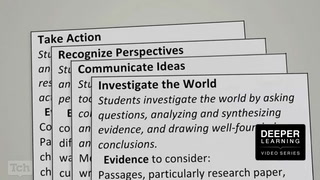SAGE: A Framework for Project-Based Learning Transcript
Narrator: When we’re working with teachers, one of the frameworks that we use, particularly when they’re thinking about creating project-based learning opportunities, is this phrase we used called SAGE. SAGE is a heuristic that we use to explain four things.
Teacher: What were the confusing points? What were the strong points?
Narrator: The first is that students have choice. The S stands for student choice.
Teacher: Okay. This morning, we have the last three montages.
Narrator: In this case where the students were presenting their video montage, it was a perfect example of students having to choose a theme, choose a topic.
Student: What do you guys think our claim is?
Student: I don’t know. I think your claim is kind of confusing for me.
Narrator: In that case, students had to think about in what ways they were going to communicate to an audience about their theme, making a claim, and then be able to back it up with evidence.
Teacher: Why did you put in the images of the Native American women?
Student: In our community, they have taken that step. They have progressed for us.
Student: My passion for it is what drove me to continue.
Narrator: The second part, A, is for authenticity, that there’s an authentic audience and purpose for the work.
Student: My first passage was with Project Cure, which is a nonprofit organization. What started me on that was the earthquake in Haiti.
Narrator: In other words, as an adult, there are certain things that I am expected to do in my job, and so we want students to be able to do those same types of tasks as students to get them thinking about those types of mindsets.
Student: We wanna empower the community take action.
Narrator: The G stands for global significance.
Student: We think every person plays a critical role in bringing a true end to modern day slavery. It’s happening in every country, and it’s happening here in our own city.
Narrator: Regardless of what subject I teach, I want to try to bring in global issues and topics to my curriculum.
Student: I wanna start with welcoming my committee.
Narrator: The last part, E, is for exhibition, exhibition to an authentic audience.
Student: It definitely changed my life and it moved me, in a way, because I learned so many things about myself.
Narrator: Too often, we ask students to create work or to demonstrate their learning, and they only do it for their teacher. The truth is, if they can do it for a broader audience, whether it’s their classmates or the school as a whole, this idea of exhibition to an external audience is not only a motivator, but it also gives them a greater purpose for their work.
Teacher: I wanna talk about your ability to recognize perspectives.
Narrator: I think when students feel safe, where they feel like their voice maters, I think great things happen. I think that level of engagement goes up when everyone knows that it’s a safe space for me to contribute, to ask questions, and to explore.
[End of Audio]














11 Comments
Stephanie Morris Sep 24, 2017 12:36am
Stephanie Morris Sep 24, 2017 12:22am
Trisha Walton Oct 13, 2014 10:38am
Karen Sampson May 22, 2014 10:07pm
Dianne Austin May 5, 2014 11:35am